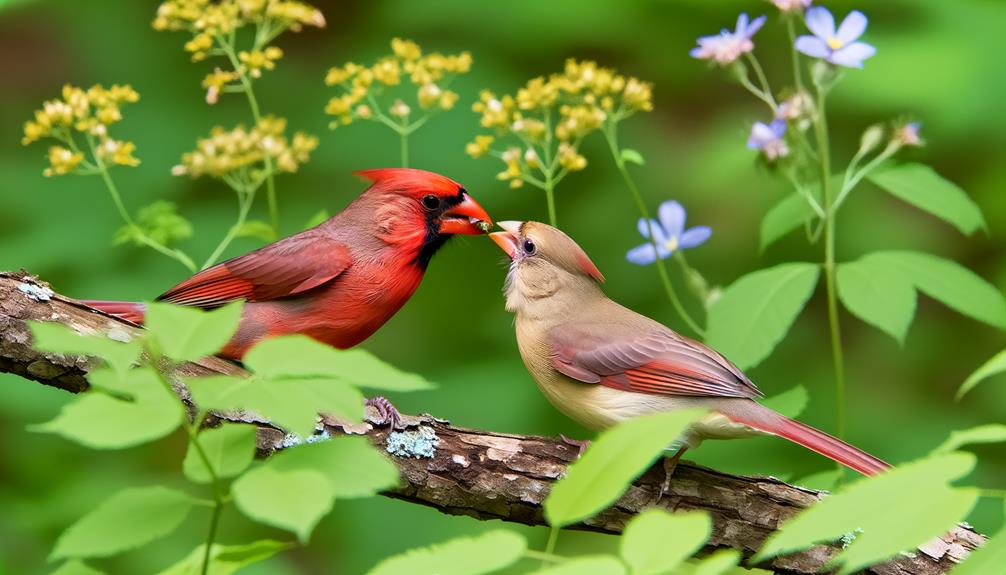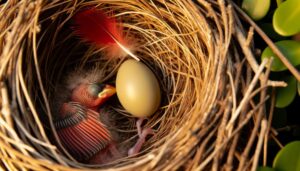How Do Male Cardinals Feed Their Mates?
Yes, male cardinals do feed their mates. This behavior is crucial to their courtship and helps strengthen the pair bond.
The male provides food directly to the female's beak, demonstrating his ability to nourish and support her. This act ensures the female meets her dietary requirements, conserving her energy for other activities such as nesting and egg-laying.
Additionally, well-fed females produce healthier eggs and more robust chicks. The frequency of mate feeding increases during the breeding season, emphasizing its significance for reproductive success.
There's more to uncover about these intriguing rituals and their influence on cardinal ecology.

Key Takeaways
- Male cardinals feed their mates directly by offering food to the female's beak.
- Mate feeding strengthens pair bonds and supports the female's nutritional needs.
- This behavior is more frequent during the breeding season.
- Well-fed females are more likely to lay viable eggs and rear healthy chicks.
- Mate feeding showcases the male's ability to provide and enhances reproductive success.
The Role of Mate Feeding
In the intricate courtship rituals of male cardinals, mate feeding plays a vital role in strengthening pair bonds and ensuring the female's nutritional needs are met during the breeding season.
You'll observe that the male cardinal brings food directly to the female, often transferring it beak-to-beak. This behavior isn't just about nutrition; it also signals the male's ability to provide, which is important for the female when selecting a mate.
Studies have shown that consistent mate feeding increases reproductive success, as well-fed females are more likely to lay viable eggs and effectively rear chicks.
Courtship Rituals of Cardinals
Courtship rituals in cardinals encompass a range of behaviors including song displays, physical posturing, and the vibrant presentation of plumage.
You'll notice male cardinals singing complex, melodious songs to attract females. These songs serve not only to woo potential mates but also to establish territory.
Additionally, males often engage in physical displays such as bowing and flicking their tails, showcasing their agility and strength.
Their bright red plumage plays a pivotal role; the more vibrant the feathers, the more attractive the male appears to females. This display of vivid coloration signals good health and genetic fitness, making the male a desirable partner.
Nutritional Benefits for Females
While observing the courtship behaviors of cardinals, you'll also notice that male cardinals often feed their mates, providing essential nutritional benefits that support the female's health and reproductive success. This feeding behavior offers several advantages:
- Enhanced Nutrition: Females receive a diverse diet, rich in necessary nutrients.
- Energy Conservation: Female cardinals conserve energy as they don't need to forage as extensively.
- Improved Egg Quality: Adequate nutrition directly contributes to higher quality eggs and offspring vitality.
- Stress Reduction: Consistent food supply reduces the stress associated with food scarcity.
These benefits collectively ensure that female cardinals remain healthy and capable of producing robust offspring. By feeding their mates, male cardinals play a vital role in the reproductive success and overall well-being of their partners.
Observing Mate Feeding Behavior
You can often observe mate feeding behavior by watching the male cardinal offer food directly to the female's beak, a practice that strengthens their bond and supports her nutritional needs.
This behavior typically occurs during the breeding season and can be seen more frequently as the pair prepares for nesting. You'll notice the male gathering food, such as seeds or insects, and then flying directly to the female.
He'll then delicately place the food in her open beak. This act isn't only a nutritional exchange but also reinforces their pair bond.
Observing this behavior requires patience and a keen eye, as it may happen quickly and is often part of a larger sequence of courtship activities.
Impact on Breeding Success
Observing mate feeding not only highlights the courtship rituals of cardinals but also greatly impacts their breeding success by ensuring the female is well-nourished and ready for egg-laying. By providing food, the male helps reduce the female's energy expenditure, leading to higher reproductive success.
Mate feeding directly influences:
- Egg production: Well-nourished females are more likely to produce a larger clutch of eggs.
- Egg quality: Nutrient-rich diets contribute to stronger, healthier eggs.
- Incubation efficiency: Females with adequate nutrition can spend more time incubating eggs without needing frequent foraging.
- Chick development: Enhanced female health translates to better parental care and stronger chicks.
Conclusion
To wrap up, you've seen that male cardinals feeding their mates is more than just a charming courtship ritual—it's a crucial behavior that boosts the female's nutritional intake and enhances breeding success.
As the saying goes, 'Actions speak louder than words,' and in this case, the male's actions directly impact the health and future of their offspring.
By observing these behaviors, you're gaining valuable insights into the intricate dynamics of cardinal reproduction.






